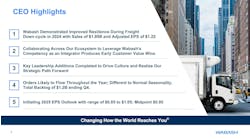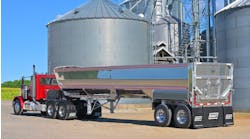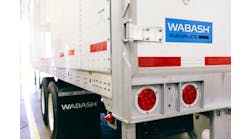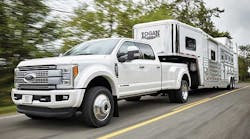Ford’s all-new 2017 Super Duty is the first new Super Duty since the 1999 model and features a lightweight aluminum alloy cab and box that save up to 350 pounds.
The new F-Series models offer “more towing and hauling capability than ever before,” according to Ford:
• The maximum payload is 4200 lbs for the 2017 Ford Super Duty F-250 and 7630 lbs for the 2017 Ford Super Duty F-350.
• Maximum conventional towing with F-250 and F-350 single-rear wheel models with the OEM’s new trailer tow package has been boosted to 18,000 lbs.
• The maximum gooseneck tow rating is 32,500 lbs for the Ford F-450 Super Duty SuperCrew 4x4, with maximum fifth-wheel towing increased to 27,500 lbs.
• The maximum gross combined weight rating for truck and trailer now tops out at 41,800 lbs; more than half the maximum weight limit of an 18-wheeler tractor-trailer combination for most federal highways.
“What it boils down to is a more efficient truck,” said Brian Rathsburg, marketing manager for the 2017 Ford F-Series Super Duty. “If you can tow and haul more, that means you need to take fewer trips, which benefits you on fuel economy, certainly, but also in time savings. Time is money for commercial customers and if you can be more efficient and also more capable at the same time that lowers the overall cost of ownership for the vehicle.”
Several new technologies augment the 2017 Super Duty payload and towing capabilities:
• An adaptive cruise control and collision warning system with brake support for towing heavy trailers, allowing operators to traverse steep mountain grades while maintaining speed, even with a trailer weighing 32,500 lbs.
• A center high-mounted stop lamp camera to provide visibility into the cargo box that is especially helpful when hooking up gooseneck and fifth-wheel trailers.
• An “ultimate trailer tow” camera system that uses four digital, high-definition cameras to give the driver a 360-degree bird’s-eye view surrounding the vehicle.
• A “trailer reverse guidance” package that provides visual cues and tips to help ease backing up a trailer, along with a factory-available trailer camera can be custom-placed on a trailer to improve visibility backing up.
• An optional in-cab trailer tire pressure monitoring system, accessible from cab while stopped or on the highway.
• A blind spot information system with trailer tow that is “optimized” in Scott’s words for the Super Duty to include trailer lengths up to 33 feet long, using radar sensors in the truck’s tail lamps to monitor areas that may not be visible to the driver.
Ford is also offering several beefed-up powertrain options for its 2017 F-Series Super Duty line to enable greater payload and towing capability.
Its second-generation 6.7-liter Power Stroke V8 turbocharged diesel engine now offers 440 hp and 925 lb-ft of torque, mated to a TorqShift six-speed SelectShift automatic transmission. This package will be the standard option for every Super Duty—from F-250 to F-450—that is spec’d with a diesel engine; without requiring special tuning or unique hardware.
The second powertrain choice is a 6.2-liter V8 gasoline engine—the standard option for F-Series Super Duty models—that offers 385 hp and 430 lb-ft of torque. It will be mated to the TorqShift six-speed SelectShift automatic transmission.
Introduced in the 2016 model year, Ford is now offering its electrically assisted adaptive steering system on its 2017 Super Duty pickups.
Ford officially took the wraps off its electrically-powered adaptive steering system for its 2017 model Super Duty pickup trucks—a technology the OEM introduced on the 2016 Ford Edge Sport SUV.
Ford said it has been awarded eight patents, with 11 more filed, for its adaptive steering package—a system that electronically increases or decreases steering gear ratios by 30% to boost highway steering “comfort” as well as improve low-speed maneuverability.
Lodewijk Wijffels, Ford’s adaptive steering technical specialist, said this technology package—all contained within the steering wheel itself—combines together an electric motor, a small computer, and a gear unit.
Based on driver input and vehicle speed, the adaptive system can add or subtract rotations at the steering wheel, with up to one full revolution saved at low speeds when steering lock-to-lock. At low speeds, the system increases the angle of the front wheels as the steering wheel is turned—resulting in the driver needing to steer less to maneuver.
Adaptive steering contributes to delivering the best ride and steering of any Super Duty ever, with improved responsiveness and control.
Ford noted that its adaptive steering package is “class-exclusive” adaptive steering for 2017 model Super Duty and Edge SUV, with the Super Duty featuring a specific setting for when in tow/haul mode to further “optimize” how the truck and trailer react to steering inputs.
The 2017 Super Duty chassis cabs, including F-450 and F-550 models, get a reboot with a new product launch. The chassis cabs arrive with a 7500-lb gross front axle weight rating—up 500 lbs from previous models—designed to support bigger snowplows, utility buckets, and other vocational upfit equipment. The F-450 and F-550 chassis cabs have a combined weight rating of up to 40,000 lbs, which is half the 80,000-lb max combined weight for heavy trucks.
Ford says the chassis cabs’ frame is 95% high-strength steel and has eight times more torsional rigidity than prior models. In addition, “many components are more robust in the new Super Duty, including axles, suspension, driveline, and towing hardware,” according to the OEM. For the first time with the Super Duty trucks, the bodies boast high-strength, military-grade aluminum throughout the cab, which Ford says helps allow for “significant increases in towing and payload capability.”
The off-road, performance-themed F-150 Raptor has a fully boxed, stronger frame than its predecessor and sheds 500 lbs. It’s six inches wider than the standard F-150 and has an optional high-output 3.5L EcoBoost V6 that Ford promises will have more power and better fuel economy than the current 6.2L V8 rated at 411 hp and 434 lb-ft of torque. All the EcoBoost V6s, including a slightly milder 2.7L version for the standard F-150, get start-stop tech that shuts down the engine at stops unless towing or in 4WD.
Flexibility is the emphasis for 2017 Ford vans, with the Transit slated to offer 64 configurations—six more than the 2016 model. New configurations include the Transit 350 regular-wheelbase van, chassis cab and cutaway with single rear wheels and 9500-lb. GVWR. Fleet feedback helped drive some interior changes like a low-profile center console option to allow computer equipment mounting and easier access to the cargo area.
Also for the 2017 Transit, Ford says the output connectors for available upfitter switches are located behind the glove box for better access. The 2017 Transit Connect compact van gets a higher-performance Sync 3 media center with 6.5-inch touchscreen as either optional or standard, depending on trim level. ♦









